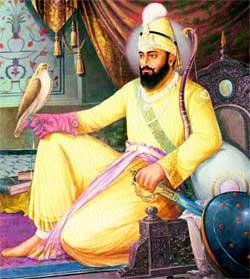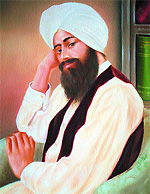drkhalsa
SPNer
- Sep 16, 2004
- 1,308
- 54
Did Guru Gobind Singh really visit the Holy City?
No Sikh historian or the SGPC confirm it, but the late Karm Singh believed that the Master had come to Amritsar. However, the facts are still open for debate and further research, writes Varinder Walia

Guru Gobind Singh
On the birth anniversary of Guru Gobind Singh today, it is pertinent to ask whether the Tenth Sikh Guru had ever visited Amritsar.
While most historians say the Guru had never visited the Majha region of Punjab, including Amritsar, a book titled “Amritsar Di Twarikh” (The History of Amritsar), authored by a historian, Mr Karam Singh, and published by the Shiromani Gurdwara Prabandhak Committee (SGPC) has claimed that the “Dasam Pita” (Guru Gobind Singh) indeed visited the Holy City in 1752 Bikrami Samant. The author substantiates his viewpoint with reference to the list of gurdwaras. The book assumes significance because it has been published by the SGPC’s Dharm Parchar Committee (DPC), to mark the tercentenary celebrations of the birth of the Khalsa Panth.
However, another book, “Gurdham Sangreh” authored by renowned the Sikh historian, Giani Gyan Singh, and also published by the SGPC does not mention any gurdwara built to commemorate the visit of the Tenth Guru. The book has now started a debate in the Sikh Panth because the SGPC’s own website does not mention any such visit. So much so, Mr Waryam Singh and Mr Roop Singh, secretary and assistant secretary of the SGPC, respectively, have differed with Karm Singh on this count.
The book has also pointed out about the gurdwara (residence of Guru Gobind Singh) that once existed at Katra Dal Singh near Kaulsar, which was built to commemorate the visit of Guru Gobind Singh to the Holy City. It claims that the gurdwara was renovated by an energetic Sikh, Mahant Gurdit Singh, in those days. The question then arises that if Guru Gobind Singh had ever visited Amritsar, then why the historical gurdwara, constructed in his memory, was allowed to “disappear”? The editor of the book, Giani Gurdit Singh, said the then President of the SGPC, Jathedar Gurcharn Singh Tohra, had evinced keen interest in its publication.
But Mr Waryam Singh says, “It was perhaps a historical error committed by Sardar Karm Singh.” However, he was unable to give an appropriate reply regarding the wisdom of publishing of the book with a “historical error” by his department (DPC), and that too on the centenary celebrations of the birth of the Khalsa Panth.
He, however, said Karm Singh had done a great service to the Panth by collecting primary sources pertaining to Sikhism. Mr Waryam Singh adds that it required more research to establish the fact regarding the visit of the tenth Guru to the Holy City. The visit of Guru Gobind Singh to Amritsar, however, got credence as the renowned Sikh historian, Giani Gurdit Singh, wrote the foreword to the book.
In the preface of the controversial book, Giani Gurdit Singh claimed that the “golden pages” of “Amritsar Di Twarikh” were found from the trash. The book contains “most valuable” information that was earlier not touched by any historian. These invaluable pages of history were found in June-July 1998 by his son Ranbir Singh from the waste papers, Giani Gurdit Singh wrote. Due to complacency, many invaluable books of Sardar Karm Singh were lost after his death, he added.
Most of the Sikh historians are of the view that Guru Gobind Singh remained busy fighting the hill chieftains and the Mughals, and hence could not find time to visit Amritsar during his lifetime. The Guru was an example of a perfect saint-soldier and had been able to build a small but well-trained army. At the age of 33 on the Baisakhi Day of 1699 AD, he established the new order of the Khalsa and gave Sikhism the present form. The Guru had to fight many battles at Anandpur, Charnkaur and Muktsar. His two sons — Ajit Singh and Jujhar Singh — died fighting at Chamkaur. The younger ones — Zorawar Singh and Fateh Singh — were captured by the ruler of Sirhind and were bricked alive. The Guru sacrificed his entire family and underwent untold hardships for righteousness.
Except for “Amritsar Di Twarikh”, any other literature, including the history of Sikhism on website of the SGPC, does not mention any visit by Guru Gobind Singh to Amritsar. The legendary saint, soldier and poet was a prolific writer. He spent his youth studying Sanskrit, Persian and other Indian scriptures. Guru Gobind Singh got compiled the final version of the Adi Granth.
The Tenth Guru was born to Mata Gujri at Patna in 1666 AD when his father Guru Teg Bahadur was touring Bengal. Guru Gobind Singh lived in Patna till the age of five. He was taken to Anandpur after that. There he went on to patronise poets, thinkers and scholars, too, which was a time-consuming exercise.
The site of the house at Patna in which Gobind Rai was born and where he spent his early childhood, now stands as a shrine— Takht Sri Harimandar Sahib— one of the five most honoured seats of Sikh religious authority (Takhts). Gobind Rai was escorted to Anandpur (then known as Chakk Nanaki) at the foothills of the Shivaliks.
Much of Guru Gobind Singh’s literary work was done at Paonta, which he had founded on the banks of Yamuna and where he had temporarily shifted in April 1685. Guru Gobind Singh reached Dina in the heart of Malwa. There he enlisted a few hundred warriors of the Brar clan, and also composed his famous letter, Zafarnamah or the Epistle of Victory, in Persian verse, addressed to Emperor Aurangzeb. He took position astride the water pool of Khidrana. After spending some time in the Lakkhi Jungle country, Guru Gobind Singh arrived at Talwandi Sabo, now called Damdama Sahib, on January 20, 1706.
From Dina, Guru Gobind Singh continued his westward march until, finding the host close upon his heels, left for the south on October 30, 1706. However, there is no mention of Guru Gobind Singh visiting Amritsar in these books on Sikh history.
A Role Model For historians

Karm Singh
The services of Karm Singh have been recognised by the Sikh Panth from time to time. He was the spirit behind the establishment of the Sikh History Research Department (SHRD) at Khalsa College, though it came into being after his death.
A year before the establishment of this historical department, a meeting was convened on December 22, 1929, at Akal Takht, and a society was formed. Karm Singh was nominated as its first secretary. Though he died on September 30, 1930, the proposal was not given up by Khalsa College that announced the setting up of the department at a meeting held at Guru Ka Bagh (Golden Temple) to mark the Shardhanjli Samaroh of the great Sikh historian the same year.
The SHRD, established in 1930, has a collection of rare paintings of the Sikh rule and the British era, old newspapers, journals that are dexterously arranged in the museum. The department has rare coins and weapons of the 17th and the 18th centuries (mathlock, dhaal, Katar, chakkar, bows and kirpans). Sardar Karm Singh was born in 1884 (Bikrami Samant) at Jhabal village, Tarn Taran in Amritsar district. His one leg was polio-affected and it is said that one day a bonesetter of the area said that the leg could be cured with Rs 5 only. An old man of the village said in a sarcastic way that the “total worth of the boy (Karm Singh) is less than that amount of money. He (the old man) perhaps did not know that the same boy would earn laurels for the region. After finishing his schooling in Tarn Taran, Karm Singh got admission in F.A. at Amritsar’s Khalsa School. However, he dropped the idea of the higher studies for the sake of research. He knew that many old men, who were eyewitness to the Sikh history, were dying due to plague and it was the need of the hour to record rare facts.

